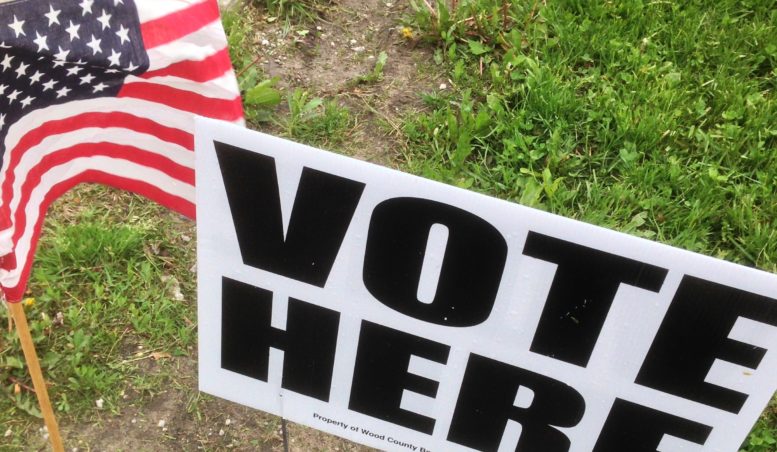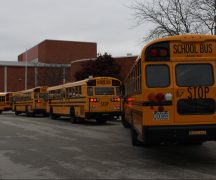The Erwin family in Southern Ohio came up with the corniest way to encourage voting this fall.
That’s a literal assessment. The family’s corn maze features a map of Ohio with the words “VOTE! 2020” etched into the design.
A presidential election corn maze is about the most Ohio thing I can think of. Speaking of elections and Ohio, let’s get to this week’s mailbag:
Got a question about Ohio politics? Send them to tbuchanan@ohiocapitaljournal.com or tweet them to @tylerjoelb.
Why does Ohio not allow a U.S. passport to be used as voter identification? Seems strange to me.
– @srobertson0726 on Twitter.
Answer: It has to do with voter verification, but Ohioans still have plenty of other ID options for Election Day.
This can seem a little counter-intuitive … a passport is secure enough to let you travel the world, but it can’t help in letting you cast a ballot for the local mayor’s election?
The issue at hand is passports do not list your address. An address is important for poll workers to confirm you are voting at the correct location, and thus voting on the correct races and issues based on where you live.
There are a number of documents a voter can provide on Election Day to prove not just their identity, but their address — examples include any utility bill, bank statement or government paper (from within the last 12 months) that lists their present address.
Of course, the most common ID shown is a driver’s license. For some voters, their valid license doesn’t list a current address if they’ve moved since the last time it was renewed. In this case, a poll worker would double-check with the address on their voter registration file.
The difference? A driver’s license is issued by the state of Ohio. A passport isn’t.
By the way, normally the rule is that a driver’s license (or any other state identification card) presented as voter ID cannot be expired. The pandemic has changed this rule for the 2020 General Election.
Any such ID card that has expired between March 9 and Election Day on Nov. 3 will remain valid for use at the polling place.
You can see a full list of acceptable voter ID options on the Ohio Secretary of State website.
Are we able to track our ‘vote by mail’ ballots online?
– @ShowMeGoodNews, on Twitter.
Answer: Yes!
All Ohioans who vote absentee by mail are indeed able to track their ballots online at voteohio.gov.
Voters must first apply to their county’s board of elections office to receive their absentee ballots. Once they have, voters can expect to receive their blank ballots in the mail sometime in early October.
After sending back their completed ballots, voters can check the status of their ballots at the above link. It will indicate to voters that the ballots have been received by the board of elections office.
Where are the early voting locations in Columbus?
– @DieHardDebH on Twitter.
Answer: This is a relevant question for all in Ohio, not just those in Columbus, so everyone should keep reading on.
This Q & A concerns early in-person voting. Each county has one such place where a voter can cast a ballot early in person: at the board of elections office.
I’ve voted this way a few times over the years; as a reporter, I’m usually busy on Election Day, and I also don’t love waiting in long lines to vote.
Early voting begins on Oct. 6 and runs all the way through the day before Election Day. There are even opportunities for evening voting and weekend voting to fit your schedule. If you aren’t planning to vote by mail or drop box, it might be worth checking into this as an alternative to voting at a traditional polling place on Nov. 3.
You can view the full early voting schedule here. It is the same schedule for all of Ohio.
You can view an Ohio boards of elections office directory here.
Reading material:
Here are some other important and interesting Ohio Capital Journal articles you have missed:
COVID-19 lawsuit immunity won’t help economy, might increase spread, poll of economists says – What will be the effect of a recent bill signed into law by Gov. Mike DeWine which gives businesses “broad immunity” from coronavirus infection lawsuits? Lawmakers and DeWine think one thing, but as reporter Marty Schladen reports, economists have a much different view.
Alleged Householder texts about nuclear bailout are MIA, House says – An affidavit from prosecutors reportedly showed a text from former Speaker of the House Larry Householder urging another lawmaker in 2019 to support House Bill 6. This bill is at the center of what prosecutors allege is the largest bribery scheme in Ohio political history. Who was that other lawmaker? Reporter Jake Zuckerman has tried to find out.
Republicans on Ohio Controlling Board reject prepaid postage for voters – Ohio voters will be on the hook for their own vote-by-mail postage this fall, I reported.
Two different surveys show that Ohio’s charities and nonprofits are in crisis – How are community organizations faring in 2020? Not well, Ohio Capital Journal contributor Kevin Williams wrote.
***
Also from Ohio Capital Journal:
Study: 96% of Black Lives Matter protests have been peaceful in Ohio
The vast majority of nationwide Black Lives Matter protests have been peaceful, including those in Ohio, according to a new study by the Armed Conflict Location & Event Data Project (ACLED).
The ACLED has been collecting data on demonstrations, political violence and other related developments since the newest phase of the BLM movement began in May, sparked by George Floyd’s death at the hands of Minneapolis police officers.
“Between 24 May and 22 August, ACLED records more than 10,600 demonstration events across the country. Over 10,100 of these — or nearly 95% — involve peaceful protesters,” the ACLED study reads. “Fewer than 570 — or approximately 5% — involve demonstrators engaging in violence.”
The study adds that more than 7,750 of the total demonstrations are connected to the BLM movement, spanning more than 2,440 locations in all 50 states and Washington, D.C. More than 93% of those events have been peaceful protests.
In Ohio, there have been 400 demonstrations across the state documented between May 24 and Sept. 5. Of those, 79.8% have been associated with the BLM movement — and 95.57% of those have been peaceful while 4.43% have had violence, looting or vandalism on the part of demonstrators.
The majority of protests have been focused in Cleveland, Cincinnati and Columbus and surrounding areas.
This data lies in stark contrast with many Americans’ perception of the BLM movement. According to a recent FiveThirtyEight poll, 42% of respondents believe “most protesters [associated with the BLM movement] are trying to incite violence or destroy property.” READ MORE





